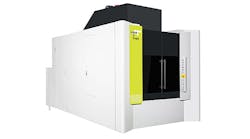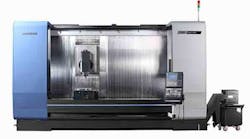The FV Series vertical machining centers — a new offering by Tongtai (formerly the OEM for Hitachi-Seiki machines, and available from Absolute Machine Tools) — are built in single-spindle and twin-spindle head designs for high-volume production lines of complex workpieces, the types of work required by manufacturers in automotive, appliance, electronics, and energy industry production.
Because of the designs’ versatility and flexibility, the machines in this series also are suitable for automated manufacturing by integrating robotic devices, either on a floor-type motion axis rail system or overhead gantry.
The fixed twin-spindle machine is able to process two individual machining tasks simultaneously. By adding an A-axis trunnion table, the FV series becomes a horizontal machining center, thus establishing the functions of two machines in the space of one, conserving shop-floor space without additional machinery costs.
Critical specifications of the machine include 1-G rapid-traverse rates in X/Y/Z, for both single and twin-spindle models of 75 m/min. and 50/100 rpms in both A and C axes. Travels for the single-spindle machine are 710/460/460 mm in X, Y, and Z. For the twin-type model the rates are 300/460/460 mm.
An automatic pallet changer is standard and can change pallets as fast as four seconds. The APC is built with triple-point clamping and supports, providing pallet stability and promoting high-quality surface finishes on parts.
The APC operates with a planetary gear rather than a worm gear, the former selected because it allows better position accuracy, zero backlash, is more durable, and reduces overall shop noise to a noticeable degree. Also, the APC is driven by servo motors rather than by the traditional hydraulic-driven method to save energy and maintenance costs.
An optional built-in tilt rotary tables or built-in tilt fixtures turn FV Series machines into five-sided or five-axis machining centers. A C-axis rotary table option has a table size of 350 mm for a single-spindle machine, or 220 mm for a twin-spindle model, each one with a 360° stroke. The A-axis trunnion rotary table design has a stroke of -30° to 180° for both single and twin models.
The automatic tool changer has a built-in tool carousel. According to the tool’s position, the FV Series is able to determine whether to move the spindle or the tool magazine to shorten tool-change time. Tool capacity is 24 for a single-spindle machine, or 48 for a twin-type design, with an 84-tool magazine as an option. Tool-to-tool change time, with retrieval via spindle or magazine, is just 1.2 seconds. A coolant-through spindle system is optional, as are various chip conveyors that accommodate different materials and chip sizes.
The Tongtai Intelligent Manufacturing System (TIMS) is among the newest technologies available in the machine tool industry. Developed by Tongtai in partnership with Fanuc Automation, this system includes four basic management functions (scalable to any size manufacturing enterprise) to improve productivity and accuracy, facilitate part production, and provide machine tool protection and maintenance assistance. The first phase, Production Management, monitors cutting loads, checks pallet change functions, records alarm messages, and assists in troubleshooting and maintenance support.
Phase two, Intelligent Management, performs motor load monitoring, implements machining adaptive control for protecting tooling and ensuring cutting efficiency, and provides crash protection for real time detection of servo loads during feeding. Tool Management records machining dates, times, and usage for tool life tracking and management, tool compensation, and tool overload protection.
The fourth phase, Workpiece Management, incorporates software using a built-in CCD camera to monitor the characteristics of a particular workpiece, and will calculate and compensate program coordinates for maximizing machining precision.









